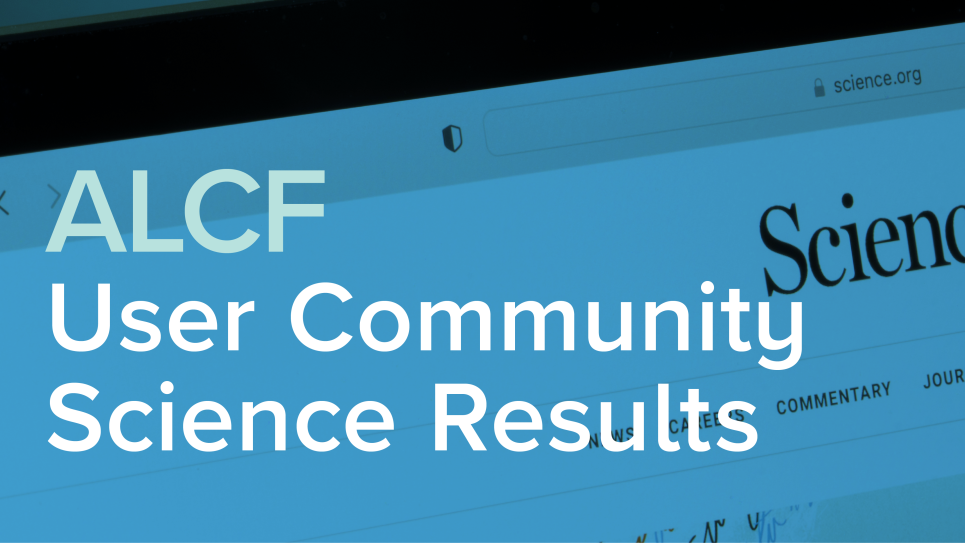
ALCF User Results: Recent publications cover ferroelectric materials, supernovae, and more
Using supercomputing resources at the ALCF, researchers produce a number of impactful studies and publications across scientific domains.
The ALCF user community continually pushes the boundaries of scientific computing, producing groundbreaking studies in areas ranging from chemistry and engineering to physics and materials science. Below, we highlight some of the recent results published by ALCF users. The ALCF is a U.S. Department of Energy user facility located at Argonne National Laboratory.
“Exploring Far-from-Equilibrium Ultrafast Polarization Control in Ferroelectric Oxides with Excited-State Neural Network Quantum Molecular Dynamics,” Science Advances
ALCF principal investigator (PI): Priya Vashishta, University of Southern California
Researchers from the University of Southern California used ALCF resources to investigate far-from-equilibrium optical control of complex polar topologies in perovskite oxides. To do so, the team implemented a multiscale excited-state neural network quantum molecular dynamics framework to study strong optical excitation in lead titanate, a prototypical ferroelectric perovskite oxide. Their work involving multiscale quantum simulation and machine learning will boost not only the emerging field of ferroelectric topotronics but also broader optoelectronic applications.
“Large-Eddy Simulations of Idealized Shock/Boundary-Layer Interactions with Crossflow,” AIAA Journal
ALCF PI: Johan Larsson, University of Maryland
For this study, researchers used ALCF supercomputers to investigate supersonic turbulent boundary layers and their interaction with shock waves. The team’s work leverages large-eddy simulations to study an idealized shock/boundary-layer interaction problem that is 2D in the mean but with a three-component mean velocity field. Certain aspects of three-dimensionality are isolated so as to glean insights into the differences between 2D and 3D problems.
“The Character of Three-Dimensional Core-Collapse Simulation Results,” The 16th International Symposium on Nuclei in the Cosmos
ALCF PI: Adam Burrows, Princeton University
The authors highlight early phases in core-collapse supernovae and the birth of neutron stars, presenting graphics that summarize the results of nearly fifty 3D radiation/hydrodynamic simulations carried out by their research group during the previous three years. The images were created in collaboration with the ALCF Visualization and Data Analysis Team.
“Inference-Optimized AI and High-Performance Computing for Gravitational Wave Detection at Scale,” Frontiers in Artificial Intelligence
ALCF PI: Eliu Huerta, Argonne National Laboratory, University of Illinois at Urbana-Champaign, and University of Chicago
Using AI models trained to detect gravitational waves and harnessing the entirety of the ALCF’s ThetaGPU system, the authors of this paper—including ALCF staff member Huihuo Zheng—processed an entire month’s worth of Laser Interferometer Gravitational-Wave Observatory (LIGO) data to identify all known binary black hole mergers. The team’s inference-optimized AI ensemble accomplished this without any misclassifications, while also providing a threefold speedup over traditional AI methods.
“LAMMPS—A Flexible Simulation Tool for Particle-Based Materials Modeling at the Atomic, Meso, and Continuum Scales,” Computer Physics Communications
ALCF PI: Aidan P. Thompson, Sandia National Laboratories
This paper describes several of the fundamental algorithms used in the popular molecular-dynamics simulator LAMMPs, as well as the design strategies that make the code so effective. The authors highlight recently added capabilities that include dynamic load balancing, on-the-fly visualization, magnetic spin dynamics models, and quantum-accuracy machine learning interatomic potentials.